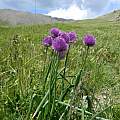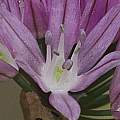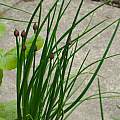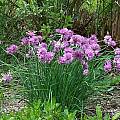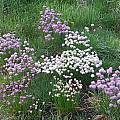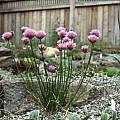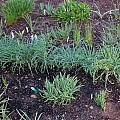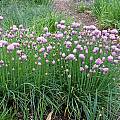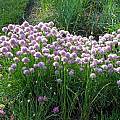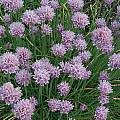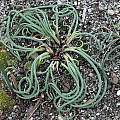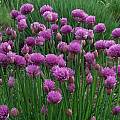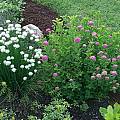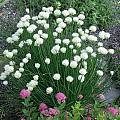Chives, the common culinary herb, is Allium schoenoprasum. The species has the widest distribution of any Allium species, and is the only one to be found both in the European and Asian continents as well as in North America. But few people realize how wildly variable this species is. So this page will be dedicated to the many faces of chives, Allium schoenoprasum, and its closely related allies.
Allium altyncolicum N.Friesen is native to Southwest Siberia. It was first published in 1987 and included in the Flora of Siberia in 2001. Height range: 30-60 cm. Photos from Mark McDonough who wrote: "For years I was puzzled by this very chive-like plant that had very un-chive-like growth habit, with striking bluish foliage that stands stiffly erect. The flowers appear later than Allium schoenoprasum, and the florets are individually larger, and with longer filaments. Without knowing of this species, it seemed like an entity somewhere between Allium schoenoprasum and Allium ledebourianum. I had dubbed it 'Blue Spear' alluding to the foliage form. I'm glad to at long last to have a name on this Siberian species. The flowers are light mauve. The last two photos show the plant in flower. The flower heads are very large and showy, appearing well after regular chives or Allium schoenoprasum is done flowering.
Allium maximowiczii Regel ssp. shibutsiense (kitam.)Ohwi 'Alba' - I obtained this from a Japanese source listed as Allium maximowiczii alba , but it's not just a white form of the much taller type species, it's the alpine form of Allium maximowiczii. The type species is found from central Asia, to China, Korea, and Japan. Allied to chives, the flowers are rather different, being shorter, more cupped-shaped, and becoming papery when going over. Dense tufts of grayish foliage, and masses of little white flowers, with height ranging from 15 to 30 cm tall. Photos by Mark McDonough.
Allium schoenoprasum L. is the species known as chives. It has a wide distribution in the temperate Northern Hemisphere. The range of chive forms provides a constant source of interest for this single species. Height range: 30-45 cm. The first photo by Andrey Dedov is of a mountain growing form from the Altai Region in Central Asia. Photos 2-5 by David Pilling show a single flower which despite being small has the same form as all alliums, seed heads with seeds on a 10 mm grid, shoots appearing in March and buds in the middle of May.
Photos by Mark McDonough show different forms. In the first photo we see a semi-dwarf form, growing 10-12" (25-30 cm) tall, with informal jostled heads of lilac-purple. In the second there is a garden view showing an array of color forms from white, through shades of pink and mauve. The last photo from Mark McDonough is of a form that was grown from seed of chives wild collected in Corsica. This was a very dwarf form, growing only 6-8" (15-20 cm) tall, with much sparser, very narrow foliage, slender stems and adorable little clusters of bloom in many colors. Subsequent seedling progeny has led to some very good selected forms. The photo shows a plant in the rock garden near Seattle, Washington.
'Curly Mauve' is a hybrid that I named, being one of the better "curly types" and a fascinating plant on many accounts. Many forms of chives actually have prostrate foliage; this one starts out prostrate, later becoming a misty blue-gray dance of medusa whips curling in all directions. In June the stems stand erect above the short curled foliage to open a sea of grayed-lavender chive florets. The five photos below show a growth progression. The last photo is a "Curly Mauve seedling", a spontaneous garden seedling that caught my eye in early spring because of the octopus-like rosette, the blue-gray curled tentacles swirling around flat on the ground. Photos by Mark McDonough.
Two other forms named and photographed by Mark McDonough are 'Marsha', a very deep purple form of chives, named for his friend Marsha Russell who had the deep form appear in her garden. Seed grown plants will vary, but a good percentage will yield similar purple forms. It grows to 2'(60 cm) tall. 'Snowcap' is shown in the second and third photos (with American species Spiraea densiflora). Mark writes: "Lots of plants go around as Allium schoenoprasum 'Alba', but it's rather ridiculous given that numerous forms of chives, from robust 2' (60 cm) tall plants to little 6" (15 cm) dwarf forms, might have white flowers. It's better to give these various white forms cultivar names. This seedling that I selected and named was derived from another dwarf white cultivar (that I also named) called 'Corsican White', the latter a miniature white-flowered form from Corsica. The selection named 'Snowcap' is a semi-dwarf, growing 12"-15" (30-38 cm) tall, with pristine white flowers."
Allium index -All alliums - Allium flavum Relatives - American alliums A-F - American alliums G-Z - Big Ball alliums - Blue alliums - Domed alliums - Drumstick alliums - Rhizomatous alliums





